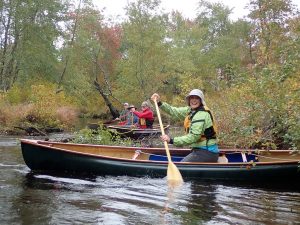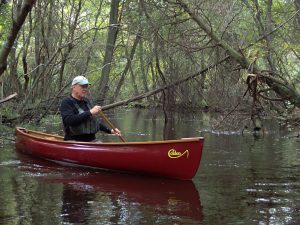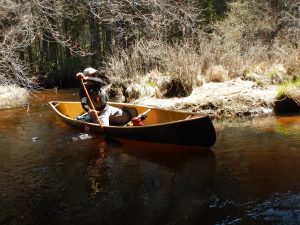by Marc Ornstein
Photography: Bruce Kemp and Rick LaLonde
|
|
|
Promoting FreeStyle has, for some time, been a pet project of mine. I’m not alone in this endeavor. In fact, I don’t know many people who are passionate about this sport who don’t in some way promote it.
Several years ago I decided to reconnect with the local chapter of the Adirondack Mountain Club. I figured that despite the explosion of kayaking there was probably still a core of folks who owned canoes for camping at least. The club’s waterways committee was very active with several evening and day trips each week. Their regular Thursday evening paddles fit well into my schedule.
When I first met the group, I was the sole canoeist. Everyone else had a rec. or touring kayak. I introduced myself and launched onto the creek. This was an up and back trip on a fairly narrow, twisty stream. I easily kept up with the group, exchanging small talk along the way. More than once I was asked why I didn’t kayak like the rest. I explained what I believed were the advantages of a canoe but had the feeling that they just didn’t get it. I avoided mentioning FreeStyle, thinking it better to simply meld with the group. I did this for several weeks. By the third or fourth week I decided it was time to demonstrate instead of explain.
The dozen or so kayaks and I had gotten as far upstream as time permitted. The creek was perhaps 20 feet wide at this point. As the kayakers attempted to turn around using forward and reverse sweeps, bumping into the banks and getting tangled in the shoreline brush, I did a simple, clean, no frills axle and side slipped into an eddy.
The cat was out of the bag. Within moments everyone in the group was asking, “how’d you do that?” In about ten seconds I had communicated by action, what for several weeks I had been unable to by words. I was now “free” to play at will, using side slips, axles, posts etc. to navigate the various streams we paddled.
cat was out of the bag. Within moments everyone in the group was asking, “how’d you do that?” In about ten seconds I had communicated by action, what for several weeks I had been unable to by words. I was now “free” to play at will, using side slips, axles, posts etc. to navigate the various streams we paddled.
Over the course of the next few weeks, members of the group and the waterways committee chair asked where they could learn these canoeing techniques. I told them about AFS, MFS and La Lou (yes, this was more than a few years ago) but it was clear that attending a three-day FS Symposium was too large a first step. That fall, at a Waterways Planning meeting I offered, come the following Spring, to teach a workshop in Practical FreeStyle. The Waterways Chair accepted the offer, but cautioned me not to expect more than a few to turn out. The few turned out to be fifteen. Somehow, I managed the group. I continued to do that workshop for a few years. Along with others, I’ve participated in running abbreviated versions of these workshops at the WPASCR, the Raystown gathering, the Regatta at Lake Arthur and other venues.


A fair number of people from these workshops have gone on to attend FS symposia but most share a common preference. They have no strong interest in pursuing the Interpretive side of FreeStyle, let alone going so far as exhibition or competition. Their interest was; How can I make the canoe go straight? How can I go upstream, around that tight bend, without the current grabbing my bow and spinning me back down? How can I get past that rock without turning broadside to the current? How can I turn around in a stream barely wider than the canoe is long? Their interest was in the basics. In short, how can they use FreeStyle techniques to navigate in the real world.
FreeStyle has, over the past several years, added a modified learning track to its core curriculum. This approach somewhat shifts the focus to emphasize the practical or functional nature of FreeStyle. Most of our events offer a “Creekin’ FreeStyle” class which is entirely functional in nature. And the “Pine Barrens Functional FreeStyle Canoeing Workshop” is an event solely dedicated to the practical application of FreeStyle techniques in real world situations.
In the real world, one may be less inclined to heel to the rail, especially if the canoe is loaded with gear; the weather is less than optimal; or, if you’re far enough south, there are scary reptiles swimming about. The aesthetics of the low, slow, horizontal crossover that is so elegant in Interpretive FS may be less important than just getting the paddle across quickly enough to cross axle into an eddy. A perfectly vertical paddle placement may be less important than the bracing obtained by a modestly angled shaft. The list goes on. The “Creekin” classes teach a variety of techniques to navigate around corners, past deadfall, over, under and through obstructions, both up and down stream.
A few folks might even come away agreeing with me that paddling upstream can sometimes be more fun than downstream.
Well, OK, maybe not…
[Editor’s note – see Marc’s Cross Post article “Go With Flow – Upstream” from 2018, to see what he’s talkin’ about…]

